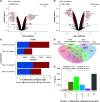Alteration of DNA methyltransferases by eribulin elicits broad DNA methylation changes with potential therapeutic implications for triple-negative breast cancer
- PMID: 38356412
- PMCID: PMC10910603
- DOI: 10.2217/epi-2023-0339
Alteration of DNA methyltransferases by eribulin elicits broad DNA methylation changes with potential therapeutic implications for triple-negative breast cancer
Abstract
Background: Triple-negative breast cancer (TNBC) is an aggressive disease with limited treatment options. Eribulin, a chemotherapeutic drug, induces epigenetic changes in cancer cells, suggesting a unique mechanism of action. Materials & methods: MDA-MB 231 cells were treated with eribulin and paclitaxel, and the samples from 53 patients treated with neoadjuvant eribulin were compared with those from 14 patients who received the standard-of-care treatment using immunohistochemistry. Results: Eribulin treatment caused significant DNA methylation changes in drug-tolerant persister TNBC cells, and it also elicited changes in the expression levels of epigenetic modifiers (DNMT1, TET1, DNMT3A/B) in vitro and in primary TNBC tumors. Conclusion: These findings provide new insights into eribulin's mechanism of action and potential biomarkers for predicting TNBC treatment response.
Keywords: DNA methylation; breast cancer; chemotherapy; epigenetic; epithelial-to-mesenchymal transition.
Conflict of interest statement
Competing interests disclosure
This study was partially supported by Eisai Inc. through a Sponsored Research Agreement, which was reviewed and approved by Eisai Inc. The authors and Eisai Inc. declare no competing interests related to the study. The authors have no other competing interests or relevant affiliations with any organization or entity with the subject matter or materials discussed in the manuscript apart from those disclosed. This includes employment, consultancies, honoraria, stock ownership or options, expert testimony, grants or patents received or pending, or royalties.
Figures






Update of
-
Alteration of DNMT1/DNMT3A by eribulin elicits global DNA methylation changes with potential therapeutic implications for triple-negative breast cancer.bioRxiv [Preprint]. 2023 Jun 10:2023.06.09.544426. doi: 10.1101/2023.06.09.544426. bioRxiv. 2023. Update in: Epigenomics. 2024 Mar;16(5):293-308. doi: 10.2217/epi-2023-0339. PMID: 37333096 Free PMC article. Updated. Preprint.
Similar articles
-
Alteration of DNMT1/DNMT3A by eribulin elicits global DNA methylation changes with potential therapeutic implications for triple-negative breast cancer.bioRxiv [Preprint]. 2023 Jun 10:2023.06.09.544426. doi: 10.1101/2023.06.09.544426. bioRxiv. 2023. Update in: Epigenomics. 2024 Mar;16(5):293-308. doi: 10.2217/epi-2023-0339. PMID: 37333096 Free PMC article. Updated. Preprint.
-
Eribulin mesilate suppresses experimental metastasis of breast cancer cells by reversing phenotype from epithelial-mesenchymal transition (EMT) to mesenchymal-epithelial transition (MET) states.Br J Cancer. 2014 Mar 18;110(6):1497-505. doi: 10.1038/bjc.2014.80. Epub 2014 Feb 25. Br J Cancer. 2014. PMID: 24569463 Free PMC article.
-
Evaluation of Copanlisib in Combination with Eribulin in Triple-negative Breast Cancer Patient-derived Xenograft Models.Cancer Res Commun. 2024 Jun 5;4(6):1430-1440. doi: 10.1158/2767-9764.CRC-24-0047. Cancer Res Commun. 2024. PMID: 38717161 Free PMC article.
-
Systematic review of Real-World effectiveness of eribulin for locally advanced or metastatic breast cancer.Curr Med Res Opin. 2020 Dec;36(12):2025-2036. doi: 10.1080/03007995.2020.1835853. Epub 2020 Oct 26. Curr Med Res Opin. 2020. PMID: 33044090
-
Eribulin mesylate: mechanism of action of a unique microtubule-targeting agent.Clin Cancer Res. 2015 Jun 1;21(11):2445-52. doi: 10.1158/1078-0432.CCR-14-3252. Epub 2015 Apr 2. Clin Cancer Res. 2015. PMID: 25838395 Free PMC article. Review.
Cited by
-
Unlocking the epigenetic code: new insights into triple-negative breast cancer.Front Oncol. 2024 Dec 18;14:1499950. doi: 10.3389/fonc.2024.1499950. eCollection 2024. Front Oncol. 2024. PMID: 39744000 Free PMC article. Review.
-
Immunomodulatory Effects of Halichondrin Isolated from Marine Sponges and Its Synthetic Analogs in Oncological Applications.Mar Drugs. 2024 Sep 20;22(9):426. doi: 10.3390/md22090426. Mar Drugs. 2024. PMID: 39330307 Free PMC article. Review.
References
-
- Nguyen HT, Huynh LAK, Nguyen TV et al. Multimodal analysis of ctDNA methylation and fragmentomic profiles enhances detection of nonmetastatic colorectal cancer. Future Oncol. 18(35), 3895–3912 (2022). - PubMed
-
- Foulkes WD, Smith IE, Reis-Filho JS. Triple-negative breast cancer. N. Engl. J. Med. 363(20), 1938–48 (2010). - PubMed
-
- Wang N, Ma T, Yu B. Targeting epigenetic regulators to overcome drug resistance in cancers. Sig. Transduct. Target Ther. 8, 69 (2023). - PMC - PubMed
-
• Understanding epigenetic regulation in tumor resistance is crucial because it offers new avenues for cancer treatment, particularly in overcoming drug resistance, a major hurdle in effective cancer therapy.
MeSH terms
Substances
Grants and funding
LinkOut - more resources
Full Text Sources
Molecular Biology Databases
Miscellaneous
